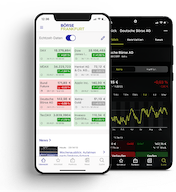Glossary
- Call (warrant)
- Cancelled order
- Cap (investment and leverage products)
- Capital increase
- Capital market
- Capital reduction
- Capital stock
- Carry trades
- Cash dividend
- Cash market
- Cash settlement (warrants)
- Cash settlement price
- Cashflow
- CDAX
- Central bank
- Certificate
- Certificate of renewal
- Changes to the composition of an index
- Chart
- Chart analysis
- Classic All Share
- Clean price
- Clearing
- Close out
- Closed-end fund
- Closing Price
- Coco bond
- Collective custody
- Commercial paper
- Commission
- Commission trading
- Commodity futures
- Commodity futures exchange
- Common gap
- Compliance guidelines
- Conditional capital increase
- Consumer Confidence
- Continuous trading
- Convertible bond
- Cooperative stock exchanges
- Corporate bond
- Correlation coefficient
- Counter transaction
- Countercyclical investment
- Countercyclical stocks
- Country risk
- Coupon
- Course notes
- Covered warrant
- Creation
- Credit risk
- Creditworthiness
- Cum
- Currency bond
- Cyclical shares
- Cyclical stocks
Carry trades
A carry trade is a speculative strategy in foreign exchange trading in which you profit from interest rate differences between two currencies. Investors borrow money in a currency with low interest rates, such as the yen, and invest it in a high-interest currency such as the US dollar. The profit arises from the interest rate difference and possible exchange rate gains. You take advantage of the price differences.
This strategy works as long as the exchange rate remains stable or moves in the desired direction. It harbors great risks if exchange rates, interest rates and volatilities change.
A current example: last week, interest rates in the USA were at 5.25 to 5.50 percent, in Japan at 0 to 0.1 percent. Then the US Federal Reserve announced an interest rate cut for September and the Bank of Japan surprisingly raised interest rates to 0.25 percent. Such changes immediately move the market, leading to strong price movements and chain reactions.




